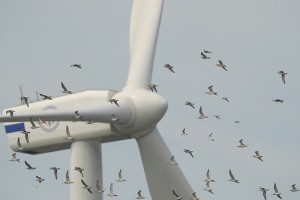To learn more about the effects of energy facilities on wildlife, the Biodiversity Research Institute (BRI) has created a wildlife and renewable energy program. The study aims to understand the movements of birds and bats and how they interact with various forms of energy such as wind turbines. BRI is currently involved in several areas of wind power research and marine spatial planning in the Eastern United States.
 “Careful siting of renewable energy development may play a key role in minimizing impacts to wildlife,” said David Evers, Ph.D., BRI’s executive director and chief scientist. “However, this requires detailed knowledge of where animals breed, winter, and migrate.”
“Careful siting of renewable energy development may play a key role in minimizing impacts to wildlife,” said David Evers, Ph.D., BRI’s executive director and chief scientist. “However, this requires detailed knowledge of where animals breed, winter, and migrate.”
For the past two and a half years, the BRI team has studied migration and movement patterns of birds and bats over the Gulf of Maine and along the Atlantic coast. They discovered that migratory owls will fly hundreds of miles out over the Atlantic on their way south to South America and the Caribbean. BRI believes this could be important in understanding how these owls, and other birds, could be affected by offshore wind turbines.
“Wind developers and wildlife managers in both the U.S. and Europe have called for the collection of preconstruction monitoring data to minimize the potential impacts of facilities on wildlife,” says Kate Williams, director of BRI’s wildlife and renewable energy program. “This can be a hot-button issue, but BRI’s main goal is to provide sound scientific data to decision makers and the public to inform debate on siting and other issues. We don’t have a pro- or anti-wind agenda.”
One of BRI’s goals is to make the information available to policy makers as well as the general public. They will be hosting a two-day workshop about the ecological effects of offshore wind power on November 8-9, 2011 at the University of Southern Main in Portland.

